Conductivity and transmittance enhancement of PEDOT:PSS thin films by graphene addition
Abstract
Compared to conventional inorganic semiconductors, organic semiconductors present several advantages, such as cost-effectiveness, mechanical toughness, synthesis versatility and simple production set-ups, among others. In this work, we have prepared conductive solid films based on multilayer graphene (mG) and poly(3,4-ethylenedioxythiophene):polystyrenesulfonate (PEDOT:PSS) from liquid dispersions. mG-10.6 wt% dispersion in isopropanol was prepared in two steps. In the first step, graphite was submitted to liquid phase exfoliation in N-methyl-pyrrolidone (NMP) (5.3 wt % of mG), then, in the following step, NMP was removed by precipitation and mG redispersed, using polyethyleneimine and acetic acid-1M in isopropanol, respectively. The nanocomposite films were prepared from dispersions of mG and PEDOT:PSS, by spin-coating, to reach pre-established solid concentrations of 10.2 wt % and 49.9 wt % of mG. The optical and electrical properties of the thin films were characterized using UV-Visible Spectroscopy and an adapted four-probe resistance measurement, while Raman Spectroscopy, Scanning Electron Microscopy (SEM), and Atomic Force Microscopy (AFM) were applied to analyze their morphological features. The thin films showed high transmittances, even multilayer, upholding more than 85% for three-layer films, similar to that found in the single-layer ones. The sheet resistances of the films were detected in the range of a few hundreds of Ω/□. Both transmittance and sheet resistance of the films were improved when compared to those found in pristine mG and pristine PEDOT:PSS, which is due to higher charge mobility in the nanocomposite. Raman Spectroscopy showed the formation of the composite by π-π interaction and the conformational change in the polymer chains was confirmed by peak shift. SEM analysis showed that the films are largely homogeneous, and mG is uniformly dispersed, nevertheless the mG platelets appear to be standing up from the film (AFM). The phase image (AFM) allows the differentiation between rigid and soft regions, i.e., mG/PEDOT and PSS, respectively. Semiconductive nanocomposites having high load of mG were successfully prepared, and their resulting electrical and optical properties make them suitable to be used, e.g., as transparent electrodes, in the fabrication of displays, lighting devices and photovoltaic materials or as multipurpose conductive inks.
Copyright (c) 2022 Nanomaterials Science & Engineering

This work is licensed under a Creative Commons Attribution-NonCommercial 4.0 International License.
Copyright Information
Authors who publish in the Nanomaterials Science & Engineering agree to the following terms:
- Authors retain copyright and grant the journal right of first publication with the work simultaneously licensed under a Creative Commons Attribution License that allows others to share the work with an acknowledgement of the work's authorship and initial publication in this journal.
- Authors are able to enter into separate, additional contractual arrangements for the non-exclusive distribution of the journal's published version of the work (e.g., post it to an institutional repository or publish it in a book), with an acknowledgement of its initial publication in this journal.
- Authors are permitted and encouraged to post their work online (e.g., in institutional repositories or on their website) after publication, as it can lead to productive exchanges, as well as earlier and greater citation of published work.
Copyrights to illustrations published in the journal remain with their current copyright holders.
It is the author's responsibility to obtain permission to quote from copyright sources.
Any fees required to obtain illustrations or to secure copyright permissions are the responsibility of authors.





